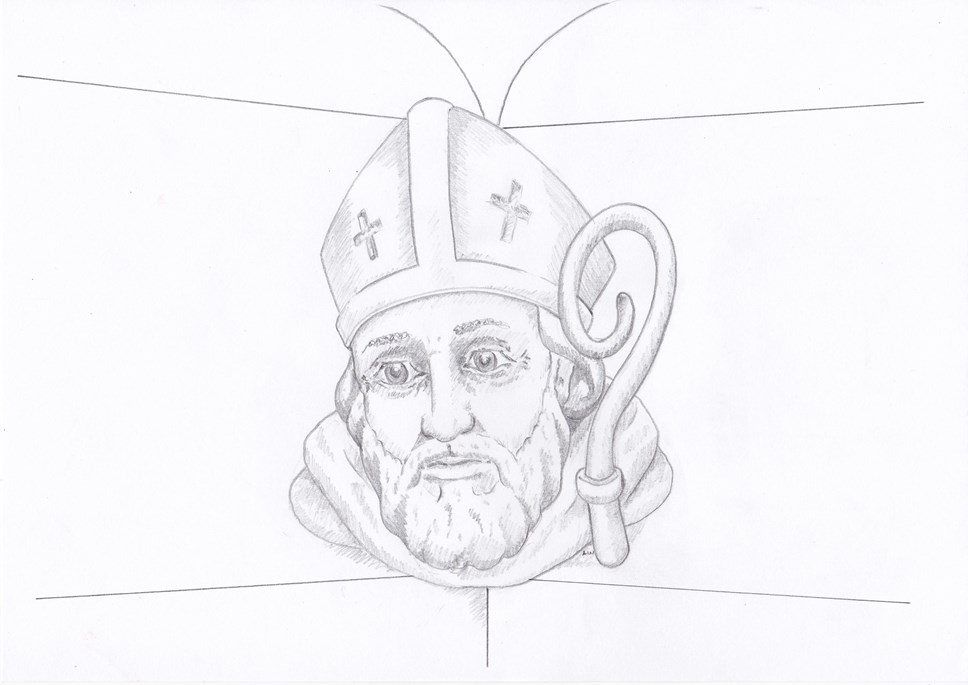
Hugh Faringdon Announced as the Winning Choice for Abbey Head Carving
- Abbot Hugh received 40% of the vote
- The carving will be unveiled in June 2021 to mark the Abbey’s 900th anniversary
HUGH FARINGDON – the last Abbot of Reading, has received just over 40% of the vote in Reading Council’s recent quest to decide on which historical figure would be added to the Abbey Gateway.
2021 marks the 900th anniversary of the foundation of Reading Abbey, once one of Europe’s largest royal monasteries, by King Henry I. As part of this year’s 900th-anniversary celebrations, the Council plans to carve one of the incomplete head-stops that decorate the outside of Reading’s Abbey Gateway.
Abbot Hugh received 40% of the vote – a clear winner taking the lion’s share - with the second most voted for option the modern stonemason, followed by Jane Austen.
A shortlist of six figures were put to the public vote in February. The first choice, Hugh Faringdon, was infamously accused of treason by Henry VIII, and publicly hung, drawn, and quartered outside the gateway in 1539. Comments from voters choosing Hugh Faringdon stated their choice would contribute to ‘righting the wrongs of the past’ and that the last Abbot of Reading needs ‘recognition’.
The winning figure will now be carved by Cliveden Conservation and the carving will be unveiled in June 2021 to mark the Abbey’s 900th anniversary.
Cllr Karen Rowland, Reading’s Lead Member for Culture, Heritage and Recreation, said: “I am pleased to announce Hugh Faringdon as our popular winner!
“What better way for us to create a lasting commemoration for Reading Abbey’s momentous 900th anniversary, than by marking the date with the completion of one of the unfinished head-stop carvings on the Abbey Gateway. Poor Hugh Faringdon met his tortured demise right outside the gateway – so, as some voters suggested, I wholeheartedly agree that it is right and fitting we give him the lasting recognition of his sacrifice, by including him alongside the likes of King Henry and Empress Matilda.
“Our modern stonemason was also a popular second choice – so who knows, in the future we may be able to look to add her alongside Hugh on the other uncarved headstop. I thought she was a spectacular choice, and the carving of contemporary faces is a well- practised tradition around the country.
"I would like to thank everyone who took the time to vote and have helped influence a lasting monument to mark this historic year! I am really looking forward to the final unveiling in June.”
Find out more at https://www.readingabbeyquarter.org.uk/visit/2021-900th-abbey-anniversary
Ends
Notes to editors
Notes
The Abbey Gateway, located along Abbot’s Walk opposite the Forbury Gardens and next to the modern-day Reading Crown Court, is one of only two complete buildings that survived the dissolution of the original Abbey back in 1538. Thanks to National Lottery players and a £1.7million grant from The National Lottery Heritage Fund, it was restored and reopened in April 2018, as part of the £3.15 million Abbey Quarter project and is now home to Reading Museum’s popular Victorian Schoolroom experience.
A stroll around the gateway reveals around 24 sculptures across its exterior – some weathered unrecognisably, but others including a dragon and a fox – remarkably surviving from medieval times. Others such as a Knight Templar, a nun, King Henry I and Queen Matilda, date from the restoration of the gate by George Gilbert Scott in 1861 and in 1900 funded by local philanthropist Dr Jamieson Hurry.
There are two uncarved Bath stone head-stops on the east side of the building, that date back to 19th Century restoration – which were left due to budget constraints.
Six potential sculptures – based on figures from the Abbey’s illustrious post-dissolution past, were shortlisted, including:
- Hugh Faringdon – the last Abbot of Reading, accused of treason by Henry VIII, and publicly hung, drawn, and quartered outside the gateway in 1539.
- Queen Elizabeth I – who used the abbot’s house and gateway as a royal palace in the 1560s.
- Jane Austen – who studied in the gateway from 1785 to 1786 when it was used as a classroom for Reading Ladies’ Boarding School.
- Sir George Gilbert Scott – the leading architect who restored the gateway back in 1861 after a thunderstorm caused the archway to collapse.
- Dr Jamieson Hurry – a local historian and philanthropist who gifted 12 carved heads in 1900
- A modern stonemason – based on a female member of the team that worked on the recent restoration of the Abbey.
2021 marks the 900th anniversary of the foundation of Reading Abbey, once one of Europe’s largest royal monasteries, by King Henry I. Find out more about the history of Reading Abbey and the gateway at www.readingabbeyquarter.org.uk
Reading’s Abbey Gateway reopened in April 2018, following restoration work as part of the £3.15 million Abbey Quarter project. Thanks to National Lottery players and a £1.7million grant from The National Lottery Heritage Fund, the gateway benefitted from vital internal refurbishment and roof repairs and is now home to Reading Museum’s popular Victorian Schoolroom experience. The Abbey Gateway is also open for special events, such as history tours, during the summer months.
About The National Lottery Heritage Fund
Using money raised by the National Lottery, we Inspire, lead and resource the UK’s heritage to create positive and lasting change for people and communities, now and in the future. www.heritagefund.org.uk
Follow @HeritageFundUK on Twitter, Facebook and Instagram and use #NationalLotteryHeritageFund

